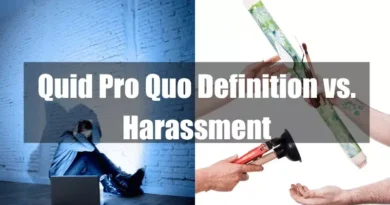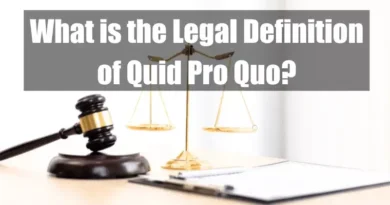Quid Pro Quo vs Bribery vs Extortion
What Are Quid Pro Quo, Bribery, and Extortion?
Quid pro quo, bribery, and extortion all involve exchanges of value under ethically and legally problematic circumstances, yet they differ in execution and intent. Quid pro quo—Latin for “something for something”—refers to a reciprocal arrangement that can be legitimate if transparent and consensual but turns unethical when it exploits power imbalances; bribery specifically entails offering, giving, receiving, or soliciting something of value to improperly influence an official’s or decision-maker’s actions; and extortion involves coercing or intimidating someone, often through threats of harm or negative consequences, to force the transfer of money, property, or favors.
Explanation
Quid pro quo, bribery, and extortion are terms that describe different types of illicit exchanges and coercive practices, each with unique characteristics and legal implications.
Quid Pro Quo: Derived from Latin meaning “something for something,” quid pro quo involves a reciprocal exchange where one party provides something of value in return for a benefit or service. This concept can appear in both legal and illegal contexts. In legal settings, quid pro quo is often a neutral term used in contract law to describe mutual consideration in agreements. However, when the exchange involves unethical or illegal favors, such as sexual harassment cases or corruption, it becomes unlawful.
Bribery: Bribery is the act of offering, giving, receiving, or soliciting something of value to influence the actions of an official or other person in a position of authority. The intent behind bribery is to corruptly alter the behavior of the recipient, making it inherently illegal. Common examples of bribery include paying off a government official to secure a contract or influencing a judge’s decision through gifts or payments.
Extortion: Extortion involves obtaining something of value through coercion, threats, or force. Unlike bribery, where the exchange is consensual, extortion is characterized by the use of intimidation or violence to force someone into compliance. This crime often involves threats of physical harm, damage to property, or exposure to sensitive information unless the victim provides money or other valuable assets.
Fundamental Differences: The main distinction lies in the exchange’s nature and consent’s presence. Quid pro quo can be legal if the exchange is fair and consensual. Bribery always involves corruption and is illegal. Extortion relies on threats and coercion, making it inherently criminal.
Commonalities: Despite their differences, these acts share commonalities in that they all involve value exchanges and can lead to ethical breaches and corruption. They undermine trust in institutions and can distort decision-making processes, leading to unfair advantages and compromised integrity.
| Aspect | Quid Pro Quo | Bribery | Extortion |
|---|---|---|---|
| Definition | Mutual exchange of value | Offering/receiving something of value | Obtaining value through coercion |
| Legal Status | Can be legal or illegal | Always illegal | Always illegal |
| Key Elements | Reciprocal benefit | Corrupt intent, value exchange | Coercion, threats |
| Common Examples | Business contracts, services | Paying off officials, influencing judges | Threats of harm, property damage |
| Legal Penalties | Context-dependent | Fines, imprisonment, disqualification | Imprisonment, fines, restitution |
| Prosecution Focus | Context of exchange | Corrupt intent | Presence of threats or coercion |
Quid Pro Quo

A. What Constitutes Quid Pro Quo?
Quid pro quo operates differently in legal and non-legal contexts. In legal scenarios, it refers to a fair exchange where each party receives a benefit. For instance, contract law ensures that both parties are mutually obligated. In employment, quid pro quo might refer to the work exchange for compensation or other benefits.
In non-legal contexts, quid pro quo can become problematic. In cases of sexual harassment, for instance, a superior might offer career advancement in exchange for sexual favors, which is illegal and unethical.
B. Is Quid Pro Quo Always Illegal?
No, quid pro quo is not always illegal. It becomes unlawful when the exchange involves unethical or illicit activities. For example, a lawyer providing services in exchange for payment is legal. However, it is illegal for a public official to accept a bribe for a favor.
C. Examples:
- Legal: A contractor completing work in exchange for payment.
- Illegal: A public official granting building permits in exchange for personal gifts.
Bribery

A. What Defines Bribery?
Bribery involves the exchange of something of value to influence the actions of an individual in a position of authority. Key elements include:
- Value Exchange: Items of value such as money, gifts, or favors.
- Corrupt Intent: The intent to influence the recipient’s actions corruptly.
- Power Position: The recipient must hold a position of power or influence.
B. Examples:
- Offering money to a government official to secure a contract.
- Giving expensive gifts to a judge to influence a legal ruling.
C. What Are the Legal Penalties for Bribery?
Bribery convictions carry severe penalties, including:
- Fines: Substantial monetary fines.
- Imprisonment: Jail sentences that can range from several years to life imprisonment.
- Disqualification: Individuals may be barred from holding public office or other positions of trust.
Extortion

A. How Is Extortion Characterized?
Extortion is characterized by obtaining something of value through coercion or threats. Unlike bribery, extortion does not involve a voluntary exchange; it relies on intimidation.
B. Execution:
- Threats: Threatening physical harm, property damage, or exposure of personal information.
- Force: Using physical or psychological force to obtain value.
C. What Are the Legal Penalties for Extortion?
Penalties for extortion are severe and include:
- Imprisonment: Lengthy prison sentences.
- Fines: Hefty financial penalties.
- Restitution: Payment to victims for damages caused by the extortion.
Comparative Analysis
A. How Do Quid Pro Quo, Bribery, and Extortion Interrelate?
Similarities:
- All involve an exchange of value.
- They can all lead to corruption and ethical breaches.
Differences:
- Quid Pro Quo: Can be legal and mutual.
- Bribery: Always illegal due to corrupt intent.
- Extortion: Always illegal due to the use of threats.
B. How Are These Crimes Prosecuted Differently?
Legal Statutes:
- Quid Pro Quo: Prosecution depends on the context of the exchange.
- Bribery: Governed by anti-bribery laws such as the Foreign Corrupt Practices Act (FCPA).
- Extortion: Prosecuted under laws against threats and coercion, like the Hobbs Act.
Prosecution Strategies:
- Quid pro quo requires proving the exchange and context.
- Bribery prosecutions focus on the corrupt intent.
- Extortion cases hinge on proving the presence of threats or coercion.
Case Studies and Statistics
A. What Are Some Notable Cases Involving These Crimes?
Quid Pro Quo:
A significant case involved Illinois Governor Rod Blagojevich, who was arrested in 2008 for attempting to sell or trade the U.S. Senate seat vacated by President Obama. This case illustrated the misuse of political power for personal gain.
Bribery:
Siemens AG, a global engineering firm, paid $1.6 billion in fines in 2008 for engaging in widespread bribery to win global contracts. This case highlighted the extensive impact of corporate bribery.
Extortion:
The Gambino crime family case in 1992, where John Gotti was convicted of multiple crimes, including extortion, showcased the use of threats and coercion by organized crime groups to extract money and enforce control.
B. What Do Statistics Reveal About These Crimes?
Bribery:
Bribery is frequently prosecuted with high conviction rates. For instance, anti-bribery laws like the Foreign Corrupt Practices Act (FCPA) lead to numerous enforcement actions. In many cases, these actions result in substantial fines and significant legal repercussions for the involved parties.
Extortion:
Extortion cases, although less common than bribery, often involve severe penalties due to their coercive nature. Data indicates high conviction rates for extortion, particularly those involving organized crime. Penalties typically include lengthy prison sentences and significant fines, underscoring the serious nature of extortion.
Conclusion
Understanding these distinctions is crucial for maintaining ethical standards and legal compliance. Public officials and private citizens must be aware of these differences to prevent involvement in illegal activities.
Implications:
- Public Officials: Must avoid any form of bribery or extortion to maintain public trust.
- Private Citizens: Awareness helps recognize and report unethical behavior.
Prevention:
- Education on legal boundaries and ethical standards.
- Strong enforcement of anti-corruption laws.
By comprehending these differences, individuals and institutions can uphold integrity and foster a fair, just society.
FAQ
What are quid pro quo, bribery, and extortion?
Quid pro quo refers to a mutually agreed exchange of benefits, bribery involves offering or receiving something of value with corrupt intent to influence decisions, and extortion is the act of obtaining value through coercion or threats. In contrast, quid pro quo can be lawful when transparent and reciprocal; both bribery and extortion breach ethical and legal boundaries by distorting the fairness of the exchange.
How do exchange principles differ among these practices?
In a quid pro quo, the exchange is voluntary and balanced, based on mutual consideration. Bribery distorts this exchange by injecting a secret incentive meant to sway decisions improperly. In contrast, extortion forces an exchange through threats or coercion, eliminating the element of free consent in the transaction.
What role does intent play across these terms?
Intent is crucial: quid pro quo is built on the intention to achieve a fair, reciprocal benefit, while bribery is driven by a corrupt intent to secure an unfair advantage. Extortion, in contrast, is characterized by the deliberate use of threats to force compliance, making the underlying motive coercive rather than mutually beneficial.
How does coercion factor into these practices?
Coercion is absent in legitimate quid pro quo arrangements, where both parties act willingly. In bribery, although the exchange may be covert, the decision is typically influenced by an improper incentive. Extortion, however, is defined by the use of coercion or threats to extract value, fundamentally undermining any notion of voluntary exchange.
What is the significance of “consideration” versus “thing of value” in these contexts?
In quid pro quo arrangements, consideration refers to both parties exchanging fair, negotiated benefits, ensuring a lawful contract. In bribery, any “thing of value” is given to illicitly influence an outcome, while in extortion, the value is forcibly extracted under duress. The legitimacy of consideration is key to lawful transactions, which is absent in the other two practices.
How does transparency differentiate these exchanges?
Transparency is the hallmark of a proper quid pro quo, where all terms are open and agreed upon. Bribery typically involves secret transactions designed to manipulate decisions, and extortion uses covert threats that prevent clear, public disclosure. The lack of transparency in bribery and extortion contributes significantly to their unethical nature.
How do these practices impact public trust and accountability?
A transparent quid pro quo promotes trust and accountability by ensuring fair exchanges. In contrast, bribery and extortion erode public trust by fostering corruption and abuse of power, as both practices involve hidden motives and illegal coercion, ultimately undermining institutional integrity.
What role does undue influence play in these practices?
Undue influence can taint a quid pro quo if one party pressures the other, though ideally, it is absent in ethical transactions. In bribery, undue influence is inherent as the incentive is meant to sway decisions improperly, while in extortion, the use of threats forces compliance, clearly indicating an abuse of power that nullifies any fair negotiation.
How do official acts intersect with these practices?
Official acts are decisions made by public officials. A quid pro quo linked to an official act is lawful if conducted openly. However, when a bribe is used to influence an official act, it becomes corrupt, and when extortion forces an official to act under threat, it completely subverts the impartiality expected in public decision-making.
What are facilitation payments, and how do they relate to these concepts?
Facilitation payments are small sums used to expedite routine actions. Any exchange is transparent and mutually agreed upon in a lawful quid pro quo. Yet, when such payments are used to influence an outcome secretly, they veer into bribery, and if demanded under threat or coercion, they resemble extortion, blurring ethical lines.
How does the “pay-to-play” concept compare across these practices?
The pay-to-play concept involves payment in exchange for access or favorable treatment. In a clear quid pro quo, such transactions are part of a regulated process. When payments are made secretly to gain improper advantages, they constitute bribery, and if such payments are coerced through implied threats of exclusion, the practice aligns with extortion.
How do kickbacks illustrate the differences among these terms?
Kickbacks are illicit returns of a portion of money from a contract, and they represent a form of bribery by secretly incentivizing favorable treatment. Unlike a transparent quid pro quo, kickbacks lack mutual consent, and if the kickback is extracted under threat or compulsion, it exhibits traits of extortion, highlighting the corrupt nature of the transaction.
How do anti-corruption laws address these three practices?
Anti-corruption laws aim to maintain fairness by enforcing transparency and proper intent in exchanges. They permit clear and consensual arrangements for legitimate quid pro quo while prohibiting bribery and extortion. The legal frameworks focus on intent, documentation, and the absence of coercion to distinguish ethical exchanges from corrupt practices.
How do legal frameworks ensure ethical exchanges over corrupt practices?
Legal frameworks enforce rigorous transparency, consent, and fair consideration standards in quid pro quo agreements. They set clear boundaries by penalizing secret, coercive transactions associated with bribery and extortion. This regulatory environment is designed to protect the public and private sectors by promoting accountability and deterring corrupt behavior.
How can organizations build compliance programs to prevent these unethical practices?
Organizations can develop robust compliance programs by clearly defining acceptable quid pro quo exchanges, instituting strict policies against bribery and extortion, and emphasizing transparency and documentation. Training, audits, and clear reporting channels help ensure that employees understand the differences in intent, consent, and fairness, thereby mitigating risks and fostering a culture of ethical conduct.









